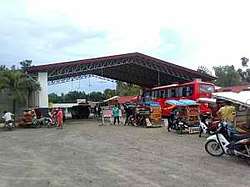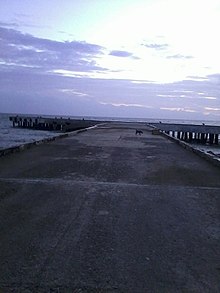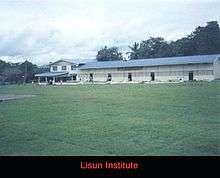Liloy, Zamboanga del Norte
Liloy, officially the Municipality of Liloy (Cebuano: Lungsod sa Liloy; Subanen: Benwa Liloy; Chavacano: Municipalidad de Liloy; Tagalog: Bayan ng Liloy), is a 3rd class municipality in the province of Zamboanga del Norte, Philippines. According to the 2015 census, it has a population of 39,812 people.[3]
Liloy | |
|---|---|
| Municipality of Liloy | |
 Integrated Bus Terminal | |
| Nickname(s): Peanut Capital of Zamboanga del Norte | |
 Map of Zamboanga del Norte with Liloy highlighted | |
OpenStreetMap 
| |
.svg.png) Liloy Location within the Philippines | |
| Coordinates: 8°07′N 122°40′E | |
| Country | |
| Region | Zamboanga Peninsula (Region IX) |
| Province | Zamboanga del Norte |
| District | 3rd District |
| Founded | August 22, 1951 |
| Barangays | 37 (see Barangays) |
| Government | |
| • Type | Sangguniang Bayan |
| • Mayor | Roberto L. Uy Jr. |
| • Vice Mayor | John Momar T. Insong |
| • Congressman | Isagani S. Amatong |
| • Electorate | 31,982 voters (2019) |
| Area | |
| • Total | 128.43 km2 (49.59 sq mi) |
| Population (2015 census)[3] | |
| • Total | 39,812 |
| • Density | 310/km2 (800/sq mi) |
| • Households | 9,344 |
| Economy | |
| • Income class | 3rd municipal income class |
| • Poverty incidence | 38.23% (2015)[4] |
| • Revenue (₱) | 111,388,507.18 (2016) |
| Time zone | UTC+8 (PST) |
| ZIP code | 7115 |
| PSGC | |
| IDD : area code | +63 (0)65 |
| Climate type | tropical climate |
| Native languages | Subanon language Cebuano Chavacano Tagalog |
| Website | www |
Liloy is mainly an agricultural community with an economy that relies mostly on crop production such as corn, rice, coconuts, peanuts, and root crops. It is known as the "Peanut Capital of Zamboanga del Norte".
Geography
Liloy's total area is 12,843 hectares (31,740 acres), 78% of which is an agricultural land planted with coconuts, corn, rice, root crops and some rubber trees. According to the records of the Municipal Assessor’s office, 22% of the municipality's territory comprise the residential area which is sixty-five (65); commercial, nine (9); industrial, in Barangay Timan and Santa Cruz, ten (10); institutional land, fifty (50); public school sites(?); and wharf, eight hundred sixty (860) hectares. There are also open areas for road right of way of public highways and roads traversing in the different barangays of the municipality.
It lies on the north-western side of the Zamboanga peninsula, bounded in the north by the Sulu Sea; south, the municipality of Tampilisan; east, the municipality of Salug; and west, the municipality of Labason.[5]
Climate
There are two distinct seasons, the dry and the rainy. Usually, the rainy season starts from the month of June and ends in December while the dry season occurs in the months of January to May. Typhoon comes rarely in this area because it is not within the typhoon belt.[5]
| Climate data for Liloy, Zamboanga del Norte | |||||||||||||
|---|---|---|---|---|---|---|---|---|---|---|---|---|---|
| Month | Jan | Feb | Mar | Apr | May | Jun | Jul | Aug | Sep | Oct | Nov | Dec | Year |
| Average high °C (°F) | 29 (84) |
30 (86) |
30 (86) |
31 (88) |
30 (86) |
29 (84) |
29 (84) |
29 (84) |
29 (84) |
29 (84) |
29 (84) |
29 (84) |
29 (85) |
| Average low °C (°F) | 23 (73) |
23 (73) |
23 (73) |
24 (75) |
25 (77) |
25 (77) |
24 (75) |
24 (75) |
25 (77) |
25 (77) |
24 (75) |
23 (73) |
24 (75) |
| Average precipitation mm (inches) | 96 (3.8) |
79 (3.1) |
117 (4.6) |
127 (5.0) |
239 (9.4) |
301 (11.9) |
286 (11.3) |
283 (11.1) |
255 (10.0) |
272 (10.7) |
188 (7.4) |
115 (4.5) |
2,358 (92.8) |
| Average rainy days | 17.3 | 16.0 | 19.7 | 21.6 | 29.0 | 29.0 | 29.7 | 29.1 | 28.5 | 28.9 | 25.3 | 20.0 | 294.1 |
| Source: Meteoblue [6] | |||||||||||||
Barangays
Liloy is politically subdivided into 37 barangays. The sitios of Silucap, Bacong, Libertad, Balacan, Tampilisan, Cabangkalan, Tambalang, and Kayoc were elevated into barrios in 1955.[7]
- Banigan
- Baybay (poblacion)
- Cabangcalan
- Canaan
- Candelaria
- Causwagan
- Communal
- Compra
- Dela Paz
- El Paraiso
- Fatima
- Ganase
- Goaw
- Goin
- Kayok
- La Libertad (Mawal)
- Lamao
- Mabuhay
- Maigang
- Malila
- Mauswagon
- New Bethlehem
- Overview
- Panabang
- Patawag
- Punta
- San Francisco
- San Isidro
- San Miguel
- San Roque
- Santa Cruz
- Santo Niño
- Silucap
- Tapican
- Timan
- Villa Calixto Sudiacal
- Villa M. Tejero
History
Liloy was once a barrio or barangay of the Municipality of Sindangan, Zamboanga del Norte. By virtue of Executive Order No. 469 issued by President Elpidio Quirino on August 22, 1951, it became an independent municipal corporation, although the municipal officials were not yet organized. The municipality was inaugurated on December 16 of the same year. The first municipal mayor of Liloy was Arsenia Almonte Teves.
Liloy subsequently lost large portions of its territory when the separate municipalities of Salug and Tampilisan were created in 1959 and 1978 respectively.[5]
In 2017, House Bill No. 5040 was introduced in the House of Representatives seeking to carve out a new province from Zamboanga del Norte. The proposed Zamboanga Hermosa province was to consist of 12 municipalities and 2 legislative districts that make up the 3rd legislative district of Zamboanga del Norte. However, the bill ultimately did not pass the 16th congress.
Demographics
| Year | Pop. | ±% p.a. |
|---|---|---|
| 1960 | 14,932 | — |
| 1970 | 26,449 | +5.88% |
| 1975 | 33,328 | +4.75% |
| 1980 | 34,841 | +0.89% |
| 1990 | 29,807 | −1.55% |
| 1995 | 32,417 | +1.59% |
| 2000 | 33,702 | +0.84% |
| 2007 | 36,948 | +1.28% |
| 2010 | 39,015 | +2.00% |
| 2015 | 39,812 | +0.39% |
| Source: Philippine Statistics Authority[3][8][9][10] | ||
Indigenous people/tribal community: Subanon[5]
Religion
| Major Religion: | Percentage |
|---|---|
| Roman Catholic | 87.28% |
| Islam | 2.00% |
| Iglesia ni Cristo | 1.06% |
| Seventh Day Adventist | 0.66% |
| Jehovah's Witness | 0.07% |
| Aglipay | 1.00% |
| UCCP | 2.15% |
| Others | 5.02% |
| Not Stated | 0.76% |
Culture
Liloy's Alay Festival was once a private-funded festival by the Tan family in Barangay Fatima to honor Nuestra Señora Birhen de Regla. At present, it is one of the most celebrated festivals in the town. The Local Government Officials contribute and show support financially and morally for the said activity.[11]
The Araw ng Liloy starts on the 22nd day of August every year. Also known as Linggo ng Liloy, the celebration is held for a week. It is highlighted by a Beauty Pageant to select the Mutya ng Liloy
Tourism
Tourism is centered on its growing developments along the beaches in the Barangays of Patawag, Banigan, Santa Cruz, Timan, and Punta, catering to white sand beaches and corals. Barangay Baybay, the seat of trade and commerce in the town, has also rapidly boomed in trade, industry, education and commerce.
The under-construction two-floor market with an escalator will be the first in the province.
Local government
Liloy is governed by a mayor, a vice mayor and eight councilors. Each official is elected publicly to a three-year term. The chief of the Association of Barangay Captains and the President of the Sangguniang Kabataan Federation are also among the members of the municipal council.
Patin "patintin" is the current mayor of the municipality. His vice mayor, Alfred U. Chan will be serving his last term as the town's vice mayor.
Municipal Hall
The Municipal Hall is a two-story Batangas-type building built in the late 1950s; repaired in 1987. A one-story annex municipal building was constructed in 1965 and later, repaired in 1990.
Transportation
Liloy can be reached from the capital city of Dipolog by overland transportation via the National Highway. The highway is parallel to the coast with a distance of 132 kilometres (82 mi). From Liloy to Zamboanga City at the very tip of the peninsula is 184 kilometres (114 mi).[5]
Bus terminals for land transportation are situated at down and uptown area (Barangay Fatima).
Liloy Airport is an airport serving the general area of Liloy. It is classified as a feeder airport by the Air Transportation Office, and under the jurisdiction of the Civil Aviation Authority of the Philippines.
It is one of the three domestic airports in the province, located in Barangay Comunal. It was first developed in 1950 under the administration of Mayor Aquilino Bomediano Sr. The first O.I.C of Liloy Airport was Tony Macias, a Filipino-American citizen.
Between the years 1960 to 1970, three twelve-seater PAL planes served their flights to domestic destinations like Dipolog, Cebu and Davao. Its usable runway length is 600 metres (2,000 ft) with a total of 1,200 metres (3,900 ft).
Current O.I.C of Liloy Airport is Edwardo Toledo. Private and government charter planes and choppers usually land at the airport.[12]
Liloy Seaport

This port is currently managed under the Philippine Ports of Authority (PPA).[13]
Education
Elementary
Liloy-I District
- Liloy CS
- Banigan ES
- Causwagan ES
- Compra ES
- Communal ES
- El Paraiso ES
- Ganase ES
- Gayam ES
- Goaw ES
- Goin ES
- Maigang ES
- Malila ES
- New Bethlehem ES
- Patawag ES
- Punta ES
- San Francisco ES
- San Miguel ES
- Silucap ES
- Tapican
Liloy-II District
- Baybay CS
- Cabangcalan ES
- Canaan PS
- Candelaria ES
- Kayok ES
- Lamao ES
- Libertad ES
- Mauswagon ES
- Overview ES
- Panabang ES
- San Isidro ES
- San Roque ES
- Santo Niño PS
- Timan ES
- Villa C. Sudiacal ES
Secondary
At present, there are 2 public institutions for high school students.
Liloy National High School- is a public institution of learning for high school students in the Liloy town and the neighboring towns like Salug, Tampilisan and some neighboring barangays in Labason. Its primary goal is to provide quality instruction to pursue the goals of Secondary Education as a link to tertiary level.
Compra National High School- is a former extension campus of the Liloy NHS located at barangay Compra, a southern part of the municipality along the National Highway. It caters students from its neighboring feeder elementary schools located in the municipalities of Liloy, Tampilisan and Kalawit.

Lisun Institute- is a private institute located in the heart of the Barangay Fatima, near the Fatima Public Market. It also offers some College courses which was founded in the 1960s.
Liloy Immanuel School- is a private school in Liloy founded by CAMACOP.[14]
Tertiary
Ave Maria College- is the first and so far the only Catholic tertiary school in the town.
References
- "Municipality". Quezon City, Philippines: Department of the Interior and Local Government. Retrieved 31 May 2013.
- "Province: Zamboanga del Norte". PSGC Interactive. Quezon City, Philippines: Philippine Statistics Authority. Retrieved 12 November 2016.
- Census of Population (2015). "Region IX (Zamboanga Peninsula)". Total Population by Province, City, Municipality and Barangay. PSA. Retrieved 20 June 2016.
- "PSA releases the 2015 Municipal and City Level Poverty Estimates". Quezon City, Philippines. Retrieved 12 October 2019.
- "Zamboanga del Norte: Liloy". Liloy, Zamboanga del Norte. 2010-03-18. Retrieved 2010-11-18.
- "Liloy: Average Temperatures and Rainfall". Meteoblue. Retrieved 30 April 2020.
- "An Act Converting into Barrios Certain Sitios in the Province of Zamboanga Del Norte". LawPH.com. Archived from the original on 2012-07-14. Retrieved 2011-04-12.
- Census of Population and Housing (2010). "Region IX (Zamboanga Peninsula)". Total Population by Province, City, Municipality and Barangay. NSO. Retrieved 29 June 2016.
- Censuses of Population (1903–2007). "Region IX (Zamboanga Peninsula)". Table 1. Population Enumerated in Various Censuses by Province/Highly Urbanized City: 1903 to 2007. NSO.
- "Province of Zamboanga del Norte". Municipality Population Data. Local Water Utilities Administration Research Division. Retrieved 17 December 2016.
- "Welcome to Zamboanga del Norte (ZaNorte) - Alay Festival Competition Showdown in Liloy successful". Archived from the original on 2011-07-24.
- "Tamed Liloy".
- "Tamed Liloy sea port".
- "Liloy Emmanuel School, Educational Institutions, -, Baybay LILOY Zamboanga del Norte". www.philippinecompanies.com. Retrieved 2010-11-19.
External links
| Wikimedia Commons has media related to Liloy, Zamboanga del Norte. |